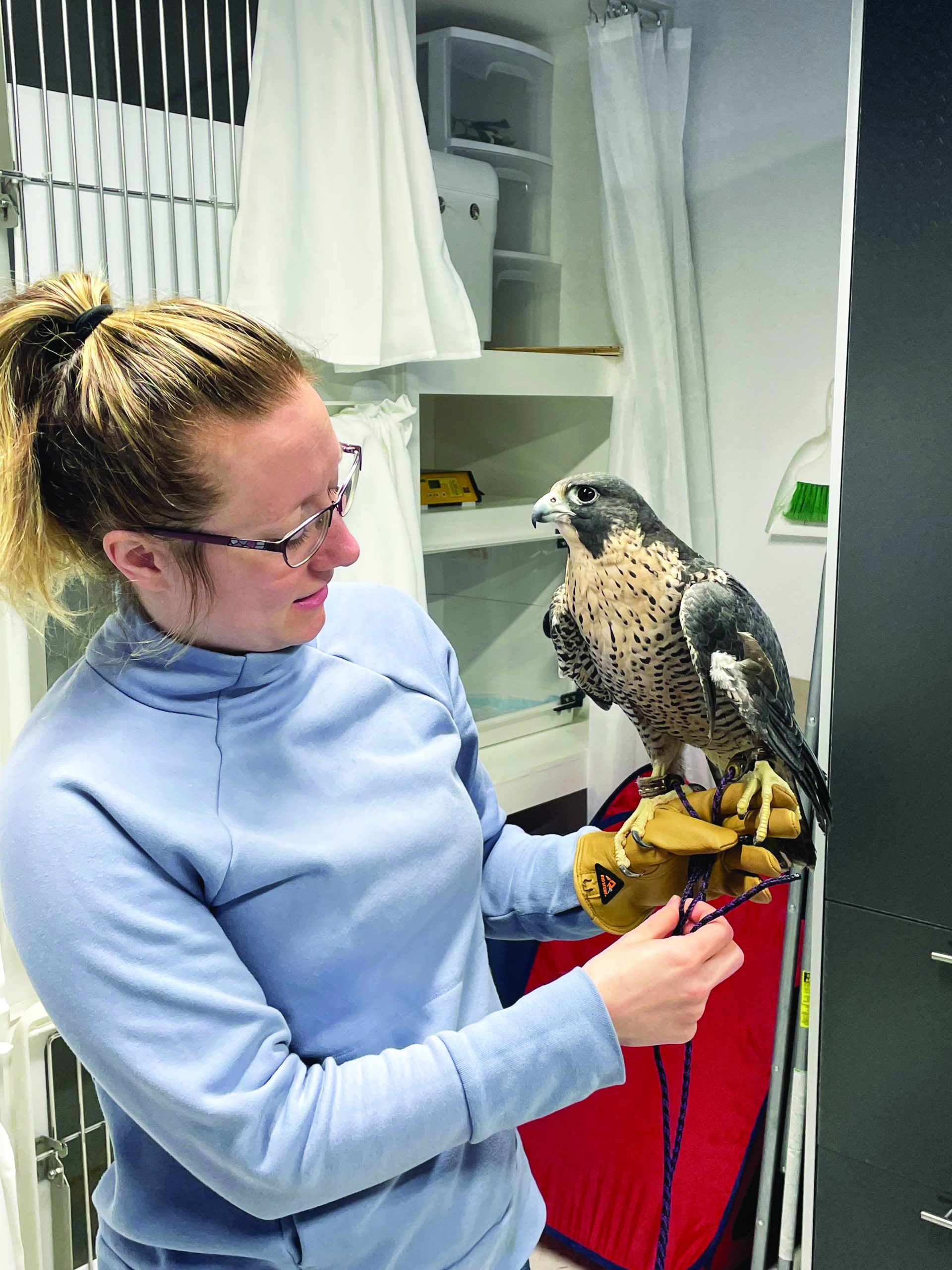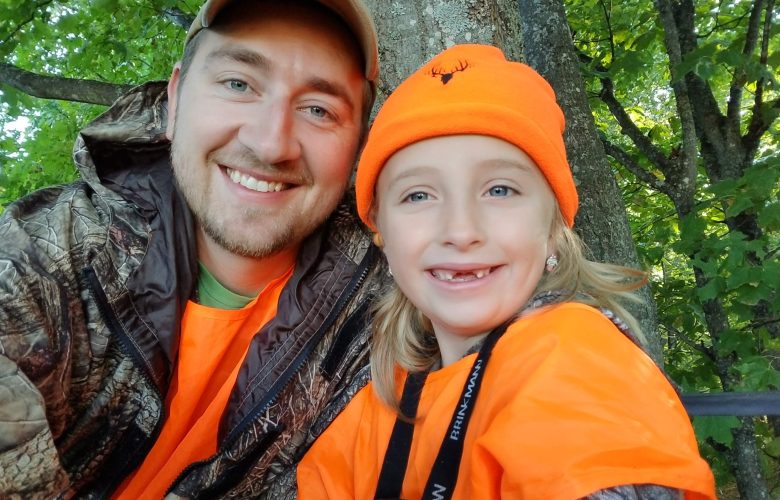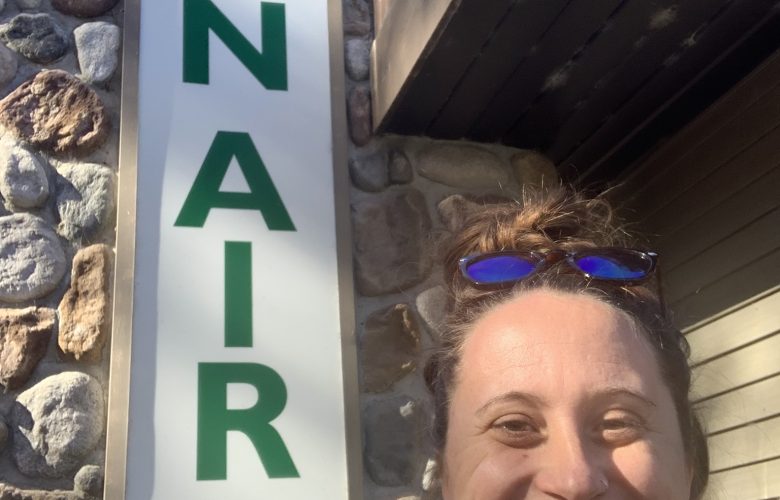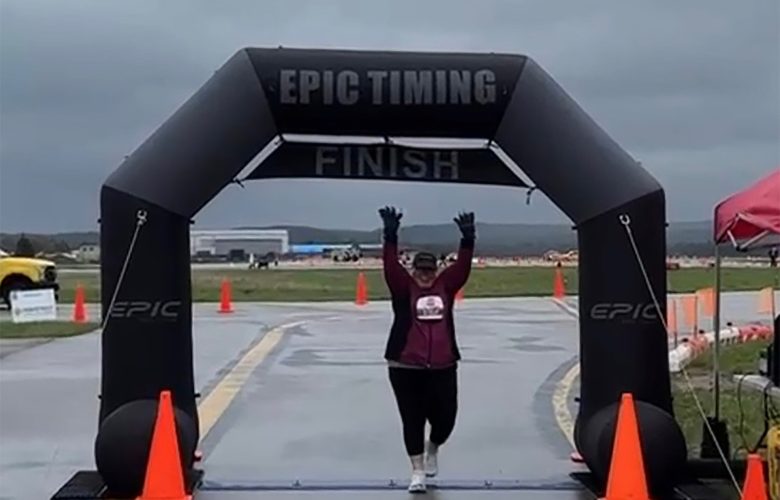Raptor sanctuary goes extra mile to save injured birds of prey
By Tim Mulherin
Current Contributor
Unlike most of us, Kaitlyn Bohnet (34) does not know how to waste time. Bohnet—who holds down a full-time job as an operations manager for a production company—also has an unusual round-the-clock avocation: rescuing raptors.
It is her call of the wild—where she gets to save birds of prey in harm’s way. Yet, unlike her employment, her rescue work never takes a holiday.
On Memorial Day, Bohnet—the executive director of North Sky Raptor Sanctuary—was notified by a concerned citizen that a near-fledgling red-shouldered hawk (Buteo lineatus) had been blown out of its nest in Ludington during a storm the day before. The scene of the unfortunate spill was the caller’s yard.
Bohnet swung into action, retrieving the distressed bird. After conducting a wellness check on the crash-lander, she contacted the Pere Marquette Township Fire Department for assistance. Given an aerial lift of some 40 feet, courtesy of the department’s ladder truck, Bohnet reunited the young hawk with its family in its maple tree nest, safe and sound.
“I can’t think of a better way to spend a rainy Memorial Day,” Bohnet laughs. But do not let that fool you: she was being totally serious.
In 2023, North Sky, headquartered in Interlochen, rescued raptors in 29 Northern Michigan counties. Outlining their area of coverage, Bohnet explains:
“It’s pretty much from Grand Rapids to the Mackinac Bridge, then everything east to west. So, if there’s a raptor in need, we’re here to help.”
The sanctuary accepts injured, ill, and orphaned eagles, hawks, owls, and vultures, filling a void left by Rebecca Lessard, who operated Wings of Wonder raptor-rehabilitation center near Empire for more than 30 years, until her retirement in 2020.
North Sky, founded by Bohnet and her husband, Jeffrey (43)—who serves as the 501(c)(3) nonprofit organization’s board chair—in 2018.
On average, the sanctuary is summoned to rescue between 75 and 125 raptors per year, says Bohnet.
“By the time they’re found, they’re either very sick or very injured,” she says.
During the pandemic, North Sky’s phone rang frequently, due to so many more people recreating in the woods—prime raptor habitat. This resulted in more discoveries of ailing predatory birds.
“It was a very busy time for us,” she recalls.
Raptors are most commonly injured by being struck by vehicles, flying into windows, and through secondary poisoning from rodent or lead toxins.
“We’ve also had a couple of fertilizer burns, especially with babies,” she adds. This includes incidents involving baby barred owls (Strix varia), who, Bohnet relates, “are on the ground early” in the spring. As they explore their surroundings, their feet can be burned by walking on chemically treated lawns.
“Barred owls don’t read,” she says wryly, regarding homeowners’ yard signs warning neighbors to keep their pet dogs and cats away for the next 48 hours once lawn fertilizer is applied. Strangely enough, wildlife can be an afterthought when it comes to animal welfare.
Bohnet’s favorite success story thus far is one that she “still can’t believe actually happened” involving a rodenticide case.
Last summer, the sanctuary took in a large adult female red-tailed hawk (Buteo jamaicensis).
“We called her Knuckles, because her feet were clenched, and we could not unclench them manually, even when she was sedated,” Bohnet explains.
Working with local veterinarians with whom North Sky partners, it was determined that the hawk was suffering from an overdose of a newer secondary pesticide that they had not previously seen in any patients. The poison was leaching all of the fluids from her body.
“It’s like the worst charley horse,” Bohnet describes.
Upon aggressive fluid therapy, Knuckles was rehydrated and eventually able to unclench her feet. She completely recovered and even foster-parented a juvenile red-tailed hawk. The two raptors were successfully released together in a public “freedom flight” on July 30, 2023, at Palmer Woods Forest Reserve in Maple City. Later, Bohnet presented this novel case to Michigan State University College of Veterinary Medicine students.
Bohnet—a self-described “bird nerd” whose knowledge of raptor behavior, anatomy, and how to medically treat these apex predators is encyclopedic—would begin her winding road to becoming a licensed raptor rehabilitator and trainer after listening to a National Public Radio (NPR) segment on falconry years ago.
Previously, she had been unaware that this ancient sport “was still practiced in modern times and in Michigan. Listening to that kind of blew my mind,” she recalls. “So I was going to change my life and become a falconer.” But before she broke this big news to her husband, she needed to “probably find out if I was afraid of the birds, because I had never been that close to them before.”
She began volunteering with a local falconer, an internship lasting for six years. When her mentor retired, Bohnet’s falconry dream morphed into an ongoing passion project of rescuing raptors.
This author got to experience firsthand just why Bohnet has dedicated herself to this wildlife-saving endeavor, as she introduced me to some of North Sky’s current residents—both temporary and permanent.
Inside the sanctuary’s clinic, I meet Raza, a “talkative” female peregrine falcon (Falco peregrinus). She is ready for her morning constitution in the backyard—and is letting her handler know it.
The bird is strikingly beautiful, and a keen intelligence emanates from her dark eyes. Due to a wing injury resulting from her fledgling flight that did not heal as hoped for, Raza is one of North Sky’s “forever kids”—ambassadors that the organization utilizes to educate the public on the ecological value and natural wonders of raptors.
For example, consider this: Peregrines in the wild are known to stoop—their unique diving method of hunting—at nearly 240 miles per hour.
In late May, North Sky took in a bald eagle (Haliaeetus leucocephalus) patient.
“She was witnessed flying with another eagle, and her left wing clipped a telephone or electrical wire,” Bohnet says. “She has extreme bruising in her radius and ulna area; that’s why it’s taped up. And she has some loose finger bones.”
Thankfully, radiographic imagery showed no fractures. Meanwhile, Bohnet will continue conservative treatment for the eagle’s injured wing, with the aim of full recovery and eventual release.
Meanwhile, Vega—a remarkably large and roughly nine-year-old female red-tailed hawk that came into the sanctuary’s care in 2017—strikes a regal pose. She is also a North Sky educational ambassador.
A young red-tailed hawk is in a separate outdoor enclosure adjacent to Vega; this one did not work out as a potential foster mother, “because she chose violence” when getting acquainted, Bohnet explains.
Next, she takes me inside one of the two outdoor enclosures—built by Jeffrey—with branches spread about at eye level. The foliage camouflages three baby screech owls (Megascops asio), approximately four weeks old; a fourth remains hidden in a nesting box.
“They came from different locations for different reasons,” she tells me. One was in a tree cavity nest about 100 feet above the ground, on private property; the tree had been cut down and transported to another location. The conscientious property owner discovered the suddenly orphaned owlet standing on a stack of logs and contacted North Sky. The good news is, once the owlets are older, all will be released.
Bohnet also shows me an American goshawk (Accipiter atricapillus) who has been at the sanctuary for the past year and who does not seem to care for my company—an astute judge of character. The goshawk is bustling nervously about his cage.
“Unfortunately, he was shot through the leg,” she reveals, “so he has a through-and-through hole.”
As I observe this magnificent specimen—the goshawk is North America’s largest accipiter, a medium-sized hawk with broad wings and a long tail that is characterized by its brief flapping-then-gliding flight pattern—I wonder aloud why anyone would shoot a raptor. She informs me that “he was probably going after somebody’s chickens.” (Of note: it’s illegal to harm or kill raptors, per the Migratory Bird Treaty Act of 1918 and Michigan law.)
Of course, not all the birds of prey who come to the sanctuary are successfully released back into the wild.
Bohnet estimates that 35 percent of their rescues are released annually, which can vary from year to year. Some of the birds are kept for educational purposes; sadly, others must be euthanized, due to the severity of their injuries.
Such weighty decisions on the prospects of the sanctuary’s patients successfully returning to and thriving in the wild are never made in a vacuum. Bohnet seeks counsel from experts with the U.S. Fish & Wildlife Service and Michigan Department of Natural Resources (MDNR).
“We do our best, knowing that, without any intervention, these animals would die anyway,” she says. “So every success we have is just mind-blowingly wonderful.”
Despite trying to maintain some emotional distance from their wild patients, it can be tough when a rescue effort does not pan out. Especially with the baby birds. Referring to “how cute” the raptor young are, Bohnet says:
“If things don’t go well with them, that’s hard.”
Admittedly, “cute” is not a word that first comes to mind when I think of wild animals. Bohnet, however, says it frequently. After my tour, I can see why.
When you observe tufted screech owlets—maybe eight inches tall—trying hard to be invisible just inches away from a human, or when viewing a photo of 10 baby barred owls draped in their fuzzy feathers, each with a uniquely nuanced facial expression, there is no getting around “cute” as the perfect adjective.
In the eye of the beholder, birds of prey, no matter their age, can indeed tug on one’s heartstring.
Should you come across an injured raptor, contact North Sky Raptor Sanctuary at 231-994-3908 or contact the MDNR via Michigan.gov/DNR online. It is worth noting that North Sky’s budget largely relies on private support and fees from educational programs; the nonprofit does not receive state or federal funding. Donations can be made at NorthSkyRaptor.org/GetInvolved online.
A version of this article first published in the Glen Arbor Sun, a Leelanau County-based semi-sister publication to The Betsie Current.
Featured Photo Caption: Raza, a female peregrine falcon and one of North Sky Raptor Sanctuary’s educational ambassadors, is readied for her daily outdoor constitution by Kaitlyn Bohnet (34). Photo by Tim Mulherin.




